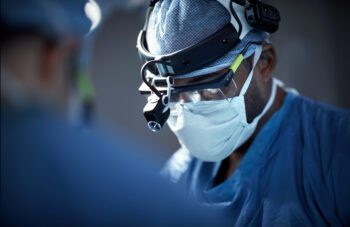The National Spine Health Foundation has been busy this spring and summer with presenting our most recent clinical studies at the annual conferences of some of the most prestigious medical societies for spine health. Traveling to conferences across the country, NSHF’s research has been presented at the International Meeting on Advanced Spine Techniques (IMAST), the Lumbar Spine Research Society (LSRS), the International Society for the Advancements of Spine Surgery (ISSAS), and the Global Spine Congress (GSC). Our clinical studies focus on patient outcomes, helping to identify the best treatment options that give the most successful outcomes. We are pleased to share this summary of studies that we have presented during this spine conference season:
The Use of Stem Cells for a Non-surgical Treatment Option for Low Back Pain
Chronic low back pain is one of the leading causes of disability and poor quality of life in the US and worldwide. Many patients fail to improve with a variety of non-surgical treatments (PT, steroid injections, medications, exercise, rest, time, activity modification). NSHF is dedicated to supporting research on the latest treatments for back pain and educating patients on treatments that are safe and effective. This study followed patients for 1 year after having an intradiscal regenerative medicine procedure for back pain using their own stem cells. There were no complications and patient reported outcome measures showed that pain and quality of life were improved at one year, suggesting regenerative medicine is a promising new non-surgical treatment for low back pain.
Reviewing Opioid Use After Elective Spine Surgery by Tracking the Number of Unused Pills Up to 90 Days After Surgery
With the advancements in minimally invasive spine surgery and modernized spine surgery recovery programs, the great news is that patients have less pain and take less pain medication after surgery than ever before. NSHF is dedicated to working towards combating the opioid crisis in America and has partnered with leading spine specialists to conduct this one-of-a-kind study that closely analyzed the opioid needs of spine surgery patients for 3 months after surgery. This study has shown the reduction in opioid usage after the most common neck and low back surgeries. Knowledge from this research may help to guide future prescribing practices after elective spine surgery.
Evaluating the Safety and Accuracy of Augmented Reality-Assisted Spine Surgery
Minimally invasive spine surgery has many advantages, but screw placement can be complex, particularly when anatomy is distorted by spinal deformity or previous spine surgery. Screw guidance techniques such as navigation and robotics are tools to guide screw placement and optimize minimally invasive options to achieve fusion. NSHF is dedicated to supporting research on the latest surgical techniques, particularly those that expand minimally invasive options for patients. This study sought to determine the safety and accuracy of a novel technology, augmented reality navigation, for spinal fusion patients. The results of one spine center’s early experience with augmented reality-assisted spine surgery demonstrated it as an effective, safe, and accurate navigation tool for screw placement.
Pelvic Fixation using Robotic-guidance Allows for Accurate Screw Placement Without Complications
There are many patients with complex spinal anatomy that require fixation from the spine to the pelvis as part of their fusion surgery. Instrumentation with S2-alar-iliac (S2AI) screws is one type of pelvic fixation, and multiple methods are available for the placement of these screws. This study aimed to evaluate complication rates, revision surgery rates, and accuracy grading for 118 robotic-guided S2AI screws. In this study, there were no medical or surgical complications related to the S2AI screws. There were also no revision surgeries performed as a result of the S2AI screws, although 17% underwent elective removal of S2AI screws after fusion was achieved due to hardware-related pain. Finally, all robotic-guided S2AI screws had the highest grade of accuracy (no breach). In summary, the robotic-guided technique for S2AI screw placement is a reliable method to achieve pelvic fixation with low complication and revision rates. In addition, a high degree of accuracy can be achieved without relying on visible and tactile landmarks needed for the freehand technique or the additional radiation associated with fluoroscopic-guidance.
A Multi-surgeon Robotic-guided Thoracolumbar Fusion Experience
Innovation in robotic guidance has been driven by a desire to improve patient safety and surgical efficiency. Robotic guidance provides indirect visualization of key anatomic landmarks to facilitate minimally invasive surgery and is emerging as a reliable and accurate technique for posterior spine instrumentation. The purpose of this study was to describe eight years of one center’s experience with robotic guidance across three robotic generations. We found that robotic guidance in thoracolumbar instrumented fusions was associated with low complication rates, revision surgery, and readmission rates. These results suggest robotic guidance can provide accurate guidance with minimal adverse events in thoracolumbar instrumentation.
Comparison of Outcomes Between the Latest Robotic Technology with Historical Fluoroscopic-Guided Controls
Current literature shows the use of robotic guidance in spine surgery can reduce complications, revision rates, and intraoperative radiation exposure and data is emerging on outcomes using the current robotic systems, including the addition of navigation. This study compares postoperative outcomes in robotic-guided lumbar fusions using the latest robotic systems with historical fluoroscopic-guided controls. The primary outcomes included: perioperative complications, revision surgery, and intraoperative exposure to fluoroscopy. These endpoints were analyzed at the following time points: intraoperatively, perioperatively, and postoperatively at 30 days, 90 days and 1 year. Findings from this study further the confidence in the latest Mazor™ robotic technology using Mazor X and Mazor X Stealth Edition as a tool to place instrumentation safely, while decreasing overall radiation exposure.
Comparing Motion Parameters Between Anterior Cervical Hybrid Surgery with Anterior Cervical Discectomy and Fusion
The standard surgical treatment for symptomatic cervical degenerative disc disease is anterior cervical discectomy and fusion (ACDF). Despite its effectiveness, one long term consequence of fusion may be increased risk of adjacent segment degeneration resulting in the need for additional surgery. Cervical disc arthroplasty has been shown to preserve physiologic range of motion (ROM) and decrease the need for adjacent segment surgery. For patients with multilevel pathology requiring at least one level of fusion, combining anterior cervical fusion with arthroplasty may maintain better ROM across the treated levels, which may decrease the burden on adjacent levels. This study primarily aimed to compare postoperative adjacent segment motion between anterior cervical hybrid surgery (ACH) and ACDF. In this study, ACH constructs partially preserved motion across the operative levels compared to the motion-sacrificing ACDF constructs. As a result, postoperative total global ROM was better in the ACH cohort and postoperative upper adjacent segment hypermobility was seen only in the ACDF group. This supports consideration of combining fusion with arthroplasty in patients with multilevel cervical pathology that require at least 1 level of fusion.



